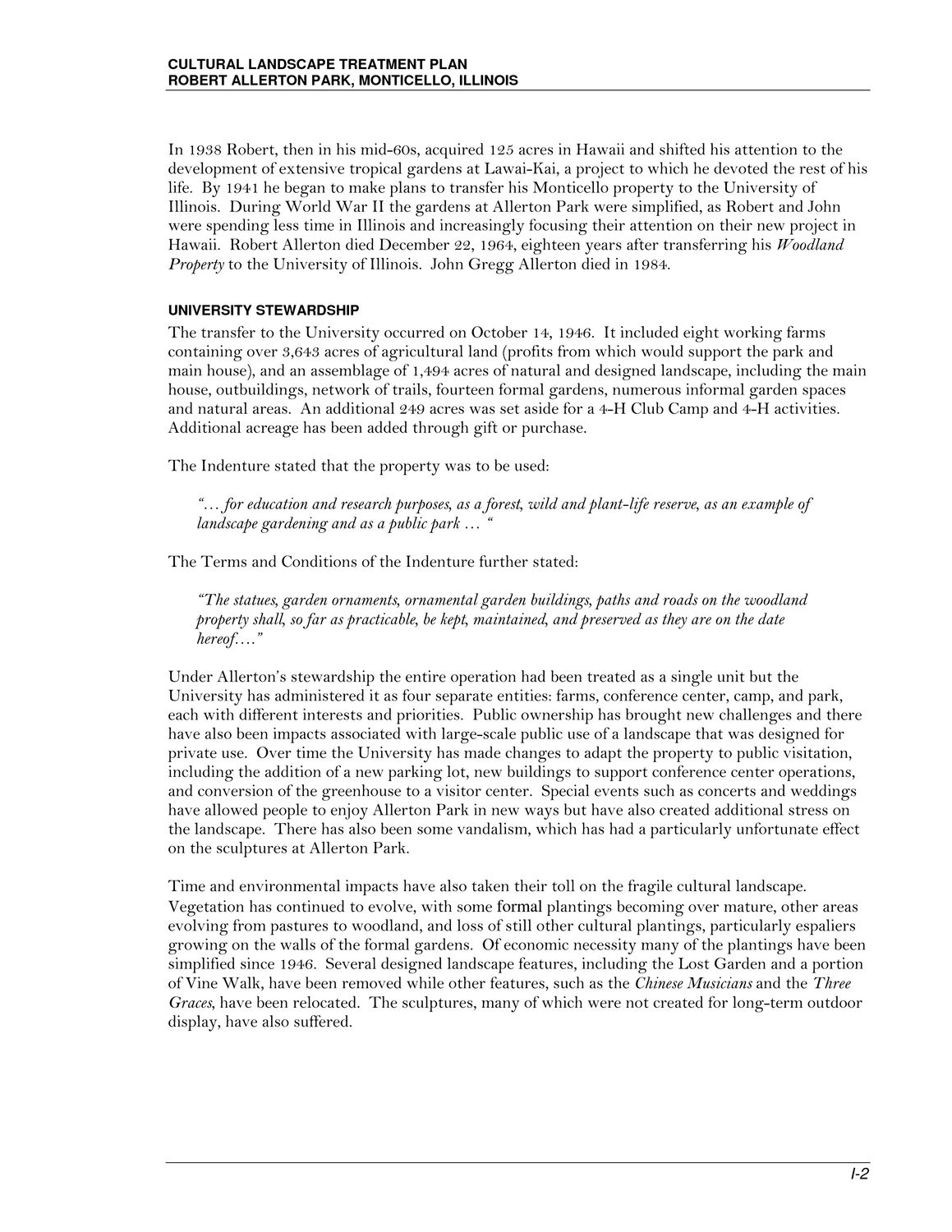| |
| |
Caption: Map of UIUC (2001) (Allerton)
This is a reduced-resolution page image for fast online browsing.

EXTRACTED TEXT FROM PAGE:
CULTURAL LANDSCAPE TREATMENT PLAN ROBERT ALLERTON PARK, MONTICELLO, ILLINOIS In 1938 Robert, then in his mid-60s, acquired 125 acres in Hawaii and shifted his attention to the development of extensive tropical gardens at Lawai-Kai, a project to which he devoted the rest of his life. By 1941 he began to make plans to transfer his Monticello property to the University of Illinois. During World War II the gardens at Allerton Park were simplified, as Robert and John were spending less time in Illinois and increasingly focusing their attention on their new project in Hawaii. Robert Allerton died December 22, 1964, eighteen years after transferring his Woodland Property to the University of Illinois. John Gregg Allerton died in 1984. UNIVERSITY STEWARDSHIP The transfer to the University occurred on October 14, 1946. It included eight working farms containing over 3,643 acres of agricultural land (profits from which would support the park and main house), and an assemblage of 1,494 acres of natural and designed landscape, including the main house, outbuildings, network of trails, fourteen formal gardens, numerous informal garden spaces and natural areas. An additional 249 acres was set aside for a 4-H Club Camp and 4-H activities. Additional acreage has been added through gift or purchase. The Indenture stated that the property was to be used: “… for education and research purposes, as a forest, wild and plant-life reserve, as an example of landscape gardening and as a public park … “ The Terms and Conditions of the Indenture further stated: “The statues, garden ornaments, ornamental garden buildings, paths and roads on the woodland property shall, so far as practicable, be kept, maintained, and preserved as they are on the date hereof….” Under Allerton’s stewardship the entire operation had been treated as a single unit but the University has administered it as four separate entities: farms, conference center, camp, and park, each with different interests and priorities. Public ownership has brought new challenges and there have also been impacts associated with large-scale public use of a landscape that was designed for private use. Over time the University has made changes to adapt the property to public visitation, including the addition of a new parking lot, new buildings to support conference center operations, and conversion of the greenhouse to a visitor center. Special events such as concerts and weddings have allowed people to enjoy Allerton Park in new ways but have also created additional stress on the landscape. There has also been some vandalism, which has had a particularly unfortunate effect on the sculptures at Allerton Park. Time and environmental impacts have also taken their toll on the fragile cultural landscape. Vegetation has continued to evolve, with some formal plantings becoming over mature, other areas evolving from pastures to woodland, and loss of still other cultural plantings, particularly espaliers growing on the walls of the formal gardens. Of economic necessity many of the plantings have been simplified since 1946. Several designed landscape features, including the Lost Garden and a portion of Vine Walk, have been removed while other features, such as the Chinese Musicians and the Three Graces, have been relocated. The sculptures, many of which were not created for long-term outdoor display, have also suffered. I-2
| |